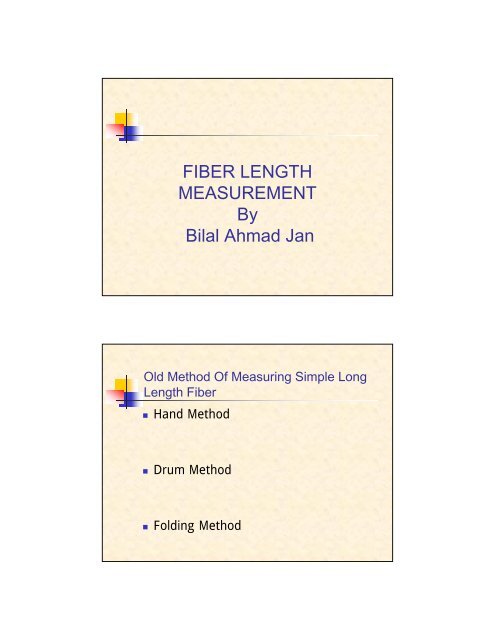FIBER LENGTH MEASUREMENT By Bilal Ahmad Jan
FIBER LENGTH MEASUREMENT By Bilal Ahmad Jan
FIBER LENGTH MEASUREMENT By Bilal Ahmad Jan
You also want an ePaper? Increase the reach of your titles
YUMPU automatically turns print PDFs into web optimized ePapers that Google loves.
<strong>FIBER</strong> <strong>LENGTH</strong><strong>MEASUREMENT</strong><strong>By</strong><strong>Bilal</strong> <strong>Ahmad</strong> <strong>Jan</strong>Old Method Of Measuring Simple LongLength Fiber• Hand Method• Drum Method• Folding Method
• Hand MethodFiber is laid on a flat , horizontalsurface wider than the fiber.<strong>By</strong> at lest 3 yards or meters long isused to measuring length• Drum MethodDrum method uses a motor-drivenmeasurement drum over which fiber arepassed .The number of drum rotation is convertedto fiber length.
Example• Wheel of Motor-Cycle is the exampleof drum method• Folding MethodIn the method fiber is foldedThe average length of a fold time thenumber of complete folds, plus thelength of any partial fold, equals thepiece length.
Fiber Length Measurement MethodsOiled-Plate Method• Measuring the length cotton and shortman-made staple fibers• The most accurate• provides the most reliable results
Method• First the fiber is dip into the liquid paraffin.• Then, the fibers are drawn out one at a timeby the tips of the little fingers of each hand ofthe operator.• The fibers are straightened and smoothed outover a centimeter scale to measure length.Semi-automatic single tester• For measuring wool and man-madefiber
WorkingComb-Sorter MethodsFiber Sorters• (i) The preparation of a fringe or tuft of fibers• (ii) The withdrawal of the fiber from thefringe in the order is either their increasing ortheir decreasing length
Scanning Methods• Give quicker results• Numerous devices have beenintroduced
Thickness-scanning• It consists essentially of three parts.• i) An intersecting comb sorter of the semiautomaticStumberger type, by means ofwhich a fringe of fibers having thecharacteristics of unmanned length• (ii) A tufting apparatus for converting theflattened fiber fringes in to a tuft
• (iii) A gauging apparatus with which thethickness of the tuft can measured fromend to end.Photo-electric scanning• Shirley P.E.M. Stapler• Photo-electric effect is used to measurelength
Principle• The image of the filament of a lampwas projected on the plane• The latter was traversed in thedirection of the fibers• The light reflected from the surfacewas focused on a photo-cell• The current generated was measuredwith a sensitive galvanometer.
Cutting-And Weighing Methods• Mathematic algebra base method• Weight is also included to measure length• This method is also know as Array methodArray Method• 75 mg of fibers be sorted into commonLength groups.• These sorted fibers are placed on a velvetboard in 0.125-inch intervals.• Sorted length categories fibers are thenweighed, starting with the longest lengthgroup.
• The mean length, upper quartile length, andother length measurements are calculatedfrom this weight data.Error• The most common error is Operatorerror in combing and sorting the fibers.
METHOD 1• i) That all fibers are at least as long as k and extend whollyacross the middle portion• (ii) That they lie straight and free from crimp• (iii) That the fiber weight per unit length is the same for alllengths• (iv) That the fibers are not tapered towards either end. Becauseof this last assumption, the results for cotton are invariably onthe low side• If L = mean fiber length,• N = number of fibers in the tuft, and• W = mean fiber weight per unit length,• Then, the total weight of fiber = Lwn,• The weight of the middle portion = kwn,• The weight of the fringes = wn(L-k), and• The ratio, r =• Whence: L=k(r+1).wn(L-k) = L - 1,kwn k
METHOD 2• The method was devised by <strong>Ahmad</strong> andNanjandayya.• In this method the length group of fiberis divided into there section.
• The length L1 and L2 arepredetermined.• Section 1 and 3 are weighed , whichgives w1 and w3 ;L3 the mean lengthof the fiber in section 3• The fiber weight per unit length insection 1 and 3 to be the same thenSoW1/L1=W3/L3L3=W3/W1*L1Total mean length will beL = L1 + L2 +(L1W3/W1)
METHOD 3• This method is know as Muller's method
• W1+W2=nL”w,L”=(W1+W3)/nw• Where W2=nkwnw=W2/KHence:L”=(W1+W3)/W2*KFiber Length Measurement Systems• HVI-Spinlab• HVI-MCI• AFIS
HVI-Spinlab• The system functions by passing a combedsample of fibers, which are assumed to be• Caught at random along their lengths, under adetection device.• The resulting fiber beard is scanned from baseto tip• The amount of light passing through thebeard is used to measure, indirectly, thenumber of fibers that extend to variousdistances.• Use for short length fiber at approximately0.15 to 0.20 inches
Measurement Error• Fiber is caught in the comb in proportionto its length.• Secondly, the detection device does notscan the random along their lengths.HVI-MCI• The system utilizes air pressure and an orifice tomeasure the pressure drop across the orifice asthe fiber specimen is passed through.• <strong>By</strong> assuming that the fibers are uniform in crosssection,the pressure drop is a measure of thenumber of fibers in the path of the airflow.
AFIS• The Advanced Fiber Information system(AFIS)• Electro-optical sensor• The output of the system includes themeasurement of the mean lengthWorking
Graph B/t V and TPLANT <strong>FIBER</strong> <strong>LENGTH</strong><strong>MEASUREMENT</strong> SYSTEM• Cotton Fiber Length MeasurementAdvanced Fiber Information System (AFIS)High Volume Instrumentation (HVI)
Modern instrument for measuringfiber lengthBeta LaserMike's Differential Speed MeasurementSystemFeatures• Easy-to-use interface• Bright, easy-to read LED display• More fast• Most accurate• Three relay outputs (GoodMeasurement, Under Tolerance, andOver Tolerance) for alarm indications
• System Diagram
















